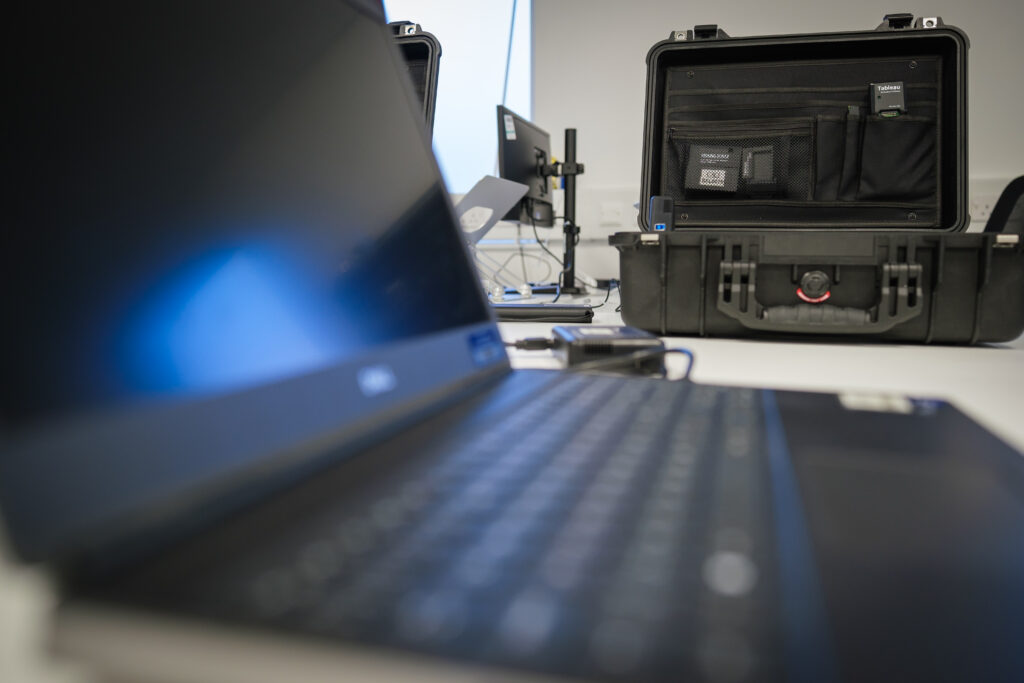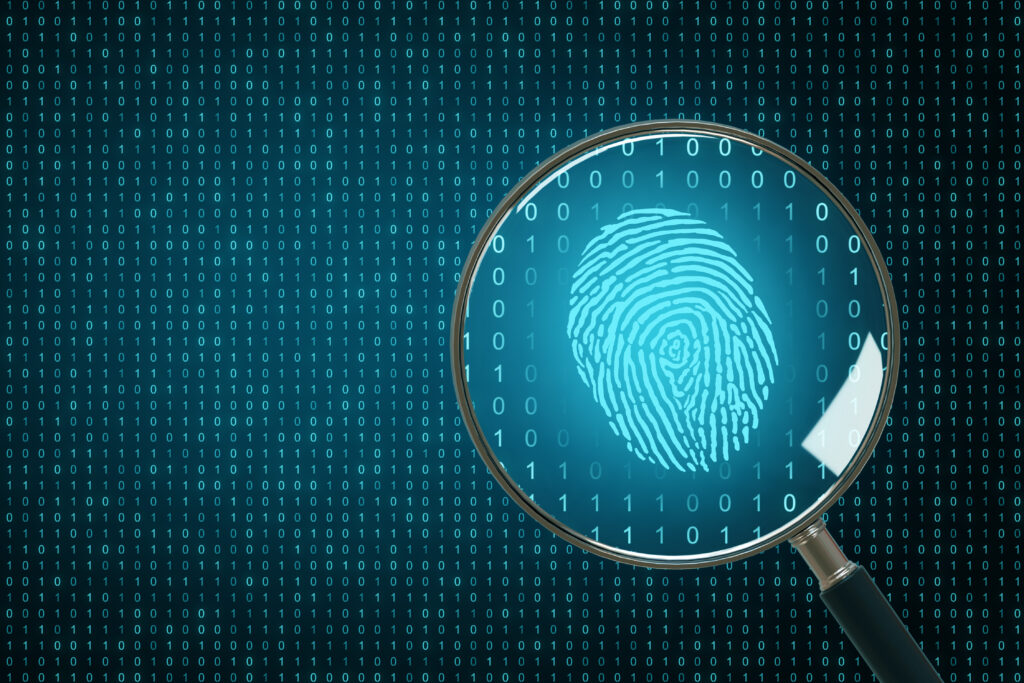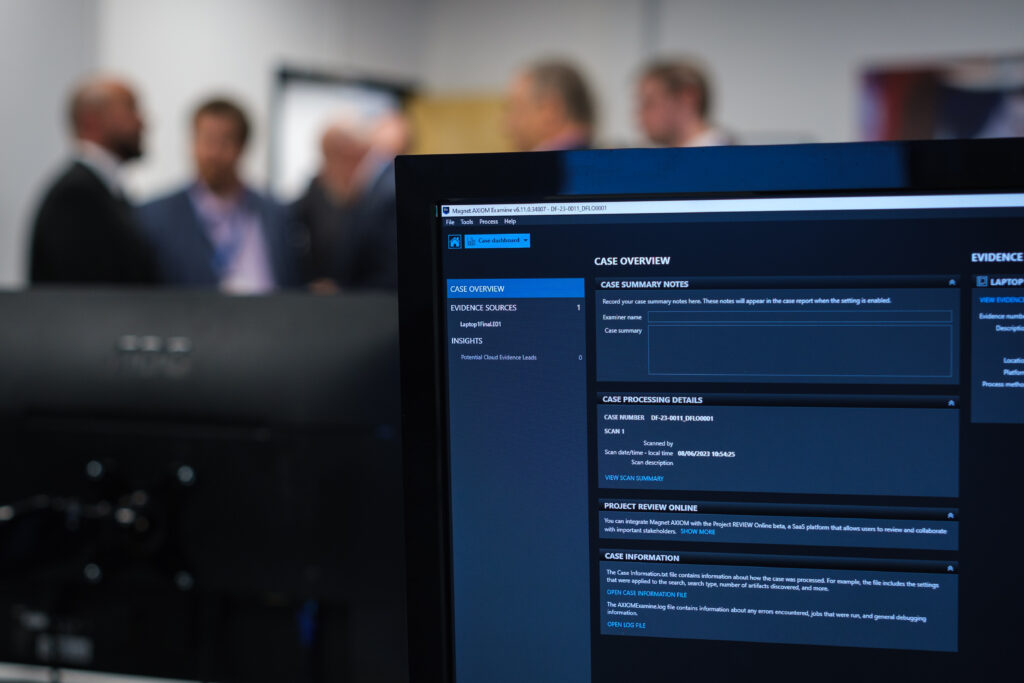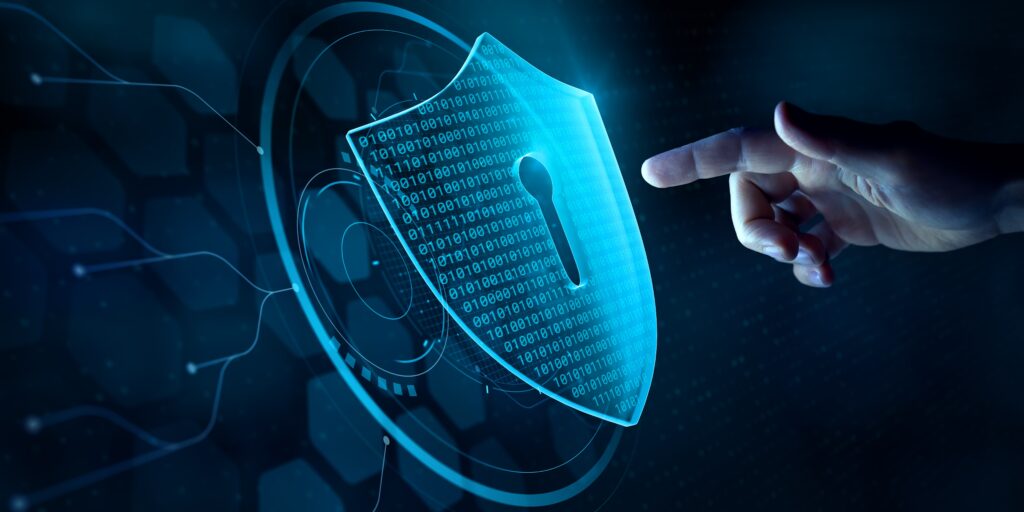What is Digital Forensics?

Digital forensics is a branch of forensic science that focuses on the recovery and investigation of digital devices, data and electronic evidence. With over 90% of crimes having a digital element associated with it nowadays, digital forensics plays a pivotal role in delivering justice within criminal investigations, from the scene of the crime to the courtroom.
So, what does digital forensics entail? What makes it integral for businesses, and how are digital forensics processes carried out? What skills must one possess to pursue a role in this industry?
What does digital forensics entail?
Digital forensics encompasses the identification, extraction and interpretation of electronic evidence from digital devices such as computers, laptops, smartphones, tablets and even network infrastructure. By examining the data on these devices, digital forensics experts can supply insights and an understanding of the events that occurred, the actions taken and the individuals involved. Within an organisation, digital forensics can be used to identify and investigate cybersecurity and physical security incidents, as well as fraud, intellectual property theft, insider threats/bad leavers, sexual misconduct and embezzlement.
Why is digital forensics integral to businesses?
Digital forensics is vital for businesses as it safeguards against data security discrepancies. Since businesses typically have an influx of digital data from financial records to customer data and intellectual property, the use of digital forensics to investigate identified issues helps them avoid financial losses and reputational damage by identifying and investigating cyber enabled or dependent crimes and securing their information.
Data preservation
Digital forensics plays a crucial role in preserving and presenting evidence for legal proceedings. When crime(s) involving digital devices occur, law enforcement agencies and businesses must gather relevant evidence for legal purposes, such as criminal prosecutions or civil litigation. Digital forensics experts follow policy and procedure documentation to ensure the integrity, preservation and authentication of electronic evidence. They create forensic copies of digital devices using validated methods, document the chain of custody and use advanced techniques to extract and analyse data without altering its original state. This aspect is vital, especially in situations where data is regularly updated or extracted from various sources. This also ensures that the evidence collected is admissible in court and can effectively support legal actions.

Digital forensics process deep dive
During an investigation, digital forensic techniques are applied to collect, preserve, and analyse digital evidence in a manner that ensures its integrity and admissibility in a court of law. With computer type devices, this involves using forensic software and hardware tools to create a digital forensic image of the device or media being examined. This image is a bit-by-bit copy of the original data, which allows investigators to work with the evidence without altering or compromising the original source. The forensic image is then processed and analysed in a controlled environment using forensic software and techniques to search for meaningful information that can be used as evidence.
In criminal cases, the digital forensics process has succeeded in identifying, apprehending and prosecuting criminals in a wide range of offenses covering both cyber enabled and cyber dependent offences. In civil litigation, digital forensics can be used in intellectual property disputes, employee misconduct investigations, and to support or challenge contractual claims.
While the digital forensics process may be unique to specific scenarios, it typically consists of the following steps:
Step 1: Collection and recovery
The digital forensic process begins with the collection and recovery of information through advanced technological methods to extract and store data from computer systems, mobile devices and other storage mediums. Recovering such a vast scope of information can be fundamental to understanding the root cause of any digital incident, whether it’s a security breach, fraud or other cybercrime.
Step 2: Examination and analysis
Once the evidence is recovered, digital forensics experts process the data using a range of tools before thoroughly analysing the data. Some examples of techniques used during analysis include file carving, registry analysis, database analysis, timeline investigation, hash comparison, filtering and keyword searching to identify relevant information that may support or refute a hypothesis or allegation. This can involve linking digital evidence between devices or people– with physical evidence or other forms of non-digital evidence– to create a comprehensive picture of the events under investigation. Digital forensics experts may need to work on a live or dead system— working live from a laptop or connecting via a hard drive to a lab computer– to decide which pieces of data are relevant to the investigation. The examination will result in a report or reports produced to address the points to prove defined within the digital evidence strategy and any data of significance presented evidentially for use in criminal or civil proceedings.
Step 3: Reporting and documentation
The reporting process is tightly controlled by the Forensic Science Regulator and ISO 17025, ensuring that the status of compliance (to those standards) of work conducted is appropriately declared and the findings of the examination cannot be misinterpreted. Reporting can come in many forms, ranging from simple to complex, in line with criminal standard reporting formats.

Types of digital evidence
Communications
Communications can occur in a wide range of mediums, from traditional emails and text messages to app-based communication, in-game, encrypted and secure communication channels.
Recovered communication data can be invaluable in establishing a suspect’s intentions, activities, connections between involved parties and potential evidence of illegal activities. Metadata relating to recovered communication data can be used during analysis to inform the investigation. Email headers, for example, can contain valuable metadata that can establish the authenticity and integrity of the communication. They can also supply information about the sender and recipient email addresses, the date and time of transmission, details of the email servers involved in the delivery process and enable investigators to define timelines and track communication flow. Attachments within emails can also give away clues about illegal activities, which can help prove a criminal’s motive, intent or even their involvement in the event in question. App based communications often contains media, links to other content or individuals of relevance and location data.
Internet activity
Internet activity can be recovered from a wide range of browsers and is often extremely valuable in determining intent– for example, recovered ‘search terms’ entered into a search engine by an individual of relevance to the investigation. Internet records can be used alongside other activity conducted on the suspect’s device when investigating a time-period of relevance to the investigation during ‘timeline’ analysis.
Application data
Mobile devices utilise software applications, or ‘Apps’, to enable the user of the device to perform a wide range of different functions. Recovered application data if often used during investigations for evidential purposes.
Logs
Logs are automated records of computer processes, user activities or communication transactions generated by computer and mobile devices. They can be compelling evidence by being able to detail who accessed a specific system and what actions were taken
Media
Videos and images are another significant type of evidence that can be used to identify and prove the physical presence of an individual at a specific location at a given time, concluding their involvement in the event in question. Metadata recovered from media is examined during analysis.
Archives
Archives involve storing offline copies or backups of databases, files or even websites. This is a practical way of retrieving lost information, which can be crucial in a digital forensics investigation. Each of these types of evidence features their own unique characteristics and functions and contributes significantly to the realm of digital forensics, aiding experts in piecing together the digital aspects of investigations and solving cases.

What challenges commonly arise in digital forensics?
Adapting along with ever-changing technology
Devices, operating systems and security are constantly changing, significantly complicating the field of digital forensics. With Windows, macOS, Linux, iOS and Android being the main operating systems used across consumer computer and mobile devices, forensics experts must innately understand each operating system’s structure and functions to effectively extract and interpret digital evidence.
Encryption and password protection
Encryption is a widely used security measure that maintains data privacy and integrity. While these techniques effectively safeguard sensitive information, they can obfuscate investigations when authorities require access to relevant data. Encryption obfuscates the data format, making it decipherable only with the correct encryption key, or password. Without these credentials, accessing the encrypted data can become impossible.
Privacy concerns
Digital forensics experts must always consider privacy while performing their work. Not only is their professional credibility at stake, but also the fundamental rights of individuals, as any breaches can lead to legal complications and reputational damage. As a result, forensics investigators must exercise caution in accessing information that is specifically pertinent to the investigation in question and that any non-relevant personal data is not intruded upon.
Establishing data authenticity and reliability
Since electronic data can be easily altered or destroyed, establishing its authenticity and reliability can be compromised, resulting in complications during court proceedings. Despite forensics professionals’ best efforts, there is always a chance that the evidence could be disallowed by the court if certain legal criteria are not met.

Emerging trends in digital forensics
The integration of artificial intelligence (AI), machine learning (ML) and blockchain technologies, coupled with a rise in mobile device forensics, are transforming digital forensics as we know it. These advancements will bolster forensics experts’ capabilities in terms of visualising and interacting with complex digital crime scenes, leading to a significant enhancement in their ability to gather crucial evidence and reconstruct events accurately.
Artificial intelligence (AI) and machine learning (ML) integration
Artificial intelligence (AI) and machine learning (ML) integration will continue to revolutionise the ways in which digital forensics experts can investigate and analyse data and evidence. Through AI-powered algorithms, experts can rapidly process large volumes of data to significantly reduce the time needed to prepare for investigations. AI and ML algorithms can also be used to identify patterns within the data that may not have been picked up during traditional, manual analysis. These algorithms can also automatically categorise and prioritise evidence to help forensics analysts assess the relevance and potential significance of collected data. Automating this process saves analysts considerable time, ensuring their focus remains on the most essential elements of the investigation. While AI can aid the investigation process, it is important to stress that digital forensic experts must never use material identified by AI as being of potential relevance within evidential reports without first reviewing and verifying it.
Implementation of blockchain technology
Blockchain characteristics– immutability, transparency and decentralisation– make it ideal for ensuring the security and integrity of digital evidence. With digital evidence traditionally stored and managed by centralised systems or authorities, potential vulnerabilities and risks emerge, as the evidence can be tampered with or manipulated, compromising the integrity of the investigation. By implementing blockchain technology, a decentralised and distributed ledger system that addresses these concerns is created. Blockchain acts as an immutable and tamper-proof record that stores all forensic activities, including the collection, analysis, and preservation of digital evidence, ensuring that any changes made to evidence will be easily detected, providing increased trustworthiness to the investigation process.
Rise of specialised mobile device forensics
Mobile device forensics has become increasingly prominent due to the widespread usage of mobile devices. It is a sub-branch of forensics that focuses on the recovery of data or information from mobile devices. This specialised area of digital forensics employs advanced tactics and approaches to analyse data, calling for an increased importance of this specialised forensics.

Certification and career opportunities
Digital forensics experts’ innate software understanding coupled with access to sophisticated tools and technology allows them to analyse and report on data effectively. These experts understand technology, computer systems and data structures to a degree that guarantees secure data evidence collection. Their roles are critical in corporate environments, where they may be tasked with examining malware, breaches or damages that can identify attackers to help organisations prevent incidents of this nature reoccurring.
Digital forensics professionals can pursue a range of classroom and online courses that cover a variety of aspects and specialisms of the field. While some organisations may task digital forensics experts with broader tasks and responsibilities, there will be a unanimous understanding of software to back these roles. A typical day could include:
- Handling exhibits, data and materials to avoid contamination or corruption.
- Disassembling and examining computers or hardware for non-volatile data storage.
- Acquiring and processing data in line with defined digital forensic strategies.
- Review processed data and analysing material(s) of relevance.
- Creating formal reports with evidence to support investigations.
Roles within Digital Forensics Units include, but are not limited to:
- Digital Forensic Technician
- Digital Forensics Investigator
- Senior Digital Forensics Investigator
- Digital Forensics Manager
- Quality Manager
- Technical Manager
- Quality Technician/Assistant
- Consultant
How can CACI help?
CACI can supply comprehensive digital forensic services that encompass computer, mobile phone device examination and scene support for law enforcement, commercial and civil investigations.
To ensure compliance with The Forensic Science Regulators Code of Practice, and ensure quality of all Digital Forensics Investigation and proficiency Testing services, the United Kingdom Accreditation Service (UKAS) has granted CACI with accreditation for ISO/IEC 17025:2017.
UKAS Recommendation Details:
Accreditation Scope: ISO/IEC 17025:2017 with compliance to ILAC G19:06/2022 and Forensic Science Regulator Code of Practice Version 1.
- Capture and preservation of data from computers and digital storage devices HDDs, SSDs, M.2 memory devices, memory cards and USB flash devices – Using FTK Imager, EnCase Imager and Tableau T356789iu.
- Capture, preservation, processing and analysis of data from Mobile Devices, SIM cards and Memory Cards – Using Cellebrite 4PC, Cellebrite Physical Analyser, MSAB XRY, MSAB XAMN and Magnet Axiom.
CACI Ltd has also been recommended for accreditation to ISO/IEC 17043:2023. This recommendation is for proficiency testing schemes relating to the acquisition, processing and analysis of computer and mobile devices.
In addition, CACI’s Digital Forensics Lab holds certification from British Standards Institute (BSI) to ISO 27001 for the provision of Digital Forensic Science Services.
To learn more about our Digital Forensic Proficiency schemes or to book a demonstration, contact us today.